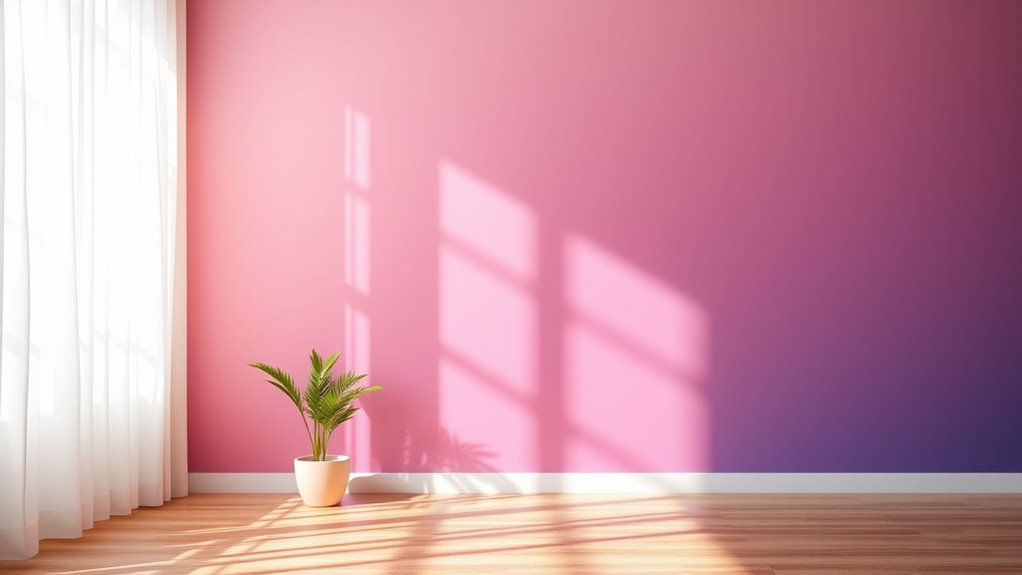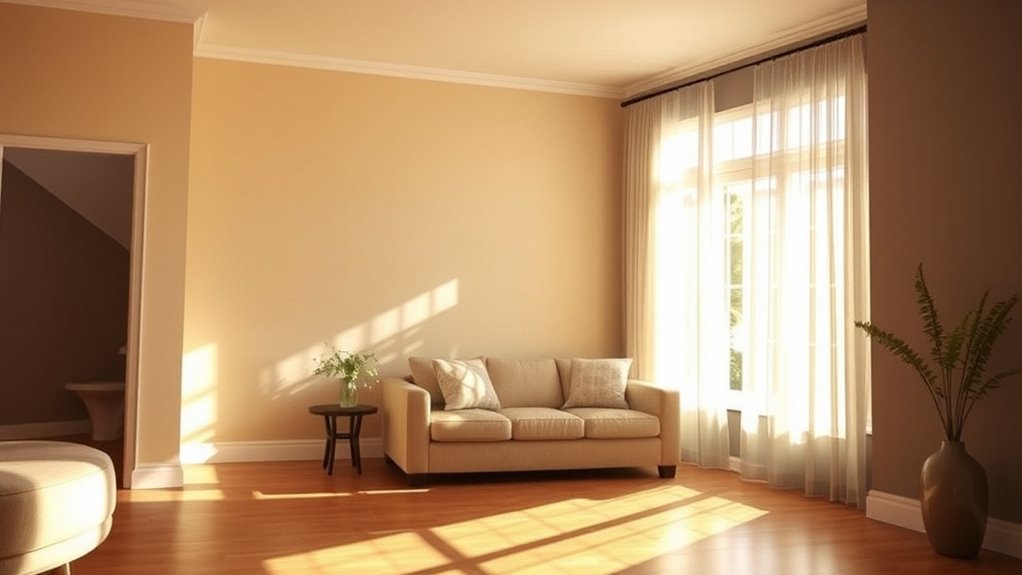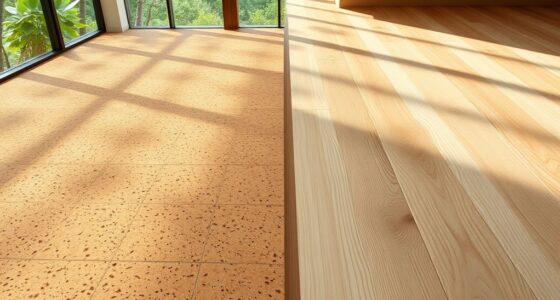When choosing paint colors, understanding how natural light affects your space is key. Sunlight can make colors appear more vivid and warm, while shadows or northern light can dull or cool their tones. The orientation of your windows also plays a role, with east, west, south, and north-facing windows adding different color influences throughout the day. To make the best choice, observe your room under various lighting conditions—more details will help you select truly harmonious shades.
Key Takeaways
- Natural light can enhance or dull colors; observe samples in different lighting conditions before choosing.
- Window orientation influences color perception, with east, west, north, and south-facing windows casting varying light tones.
- Bright sunlight intensifies vivid colors, while dimmer light makes neutral and light shades appear softer and more spacious.
- Test paint samples at different times of day to see how natural light affects their appearance and mood.
- Consider how furnishings and room features interact with natural light to select harmonious, well-suited paint colors.

Are you overwhelmed by the countless paint color options available? With so many choices, it’s easy to feel unsure about which shades will work best in your space. One of the most overlooked factors influencing your decision is natural light. The way sunlight interacts with your walls can dramatically change how colors appear, making it vital to consider light when choosing your paint. Natural light can brighten a room, making colors seem more vivid, or it can cast shadows that dull their appearance. The time of day also plays a role—colors may look different in the morning versus late afternoon, so it’s wise to observe your room under various lighting conditions before finalizing your choice.
Natural light transforms paint colors; observe your room at different times before choosing the perfect shade.
The direction your windows face impacts the type of light entering the space. East-facing windows bring in warm morning light, which can enhance warm tones like reds, oranges, and yellows, making them feel even more energetic. West-facing windows provide cooler, softer afternoon light, which can tone down bright colors or make cooler shades like blue or green appear more subdued. North-facing windows tend to cast a cooler, bluish light that can make warm hues seem less intense, while south-facing windows offer bright, direct sunlight that can intensify colors and highlight their vibrancy. Understanding these nuances helps you select a paint color that will look great throughout the day.
Colors also react differently depending on the shade and lighting. Bright, intense hues tend to appear more vivid in well-lit areas, but they can fade or look muted in dimmer settings. Conversely, light and neutral shades like beige, gray, or white work well in rooms with limited natural light, as they reflect available light and create a sense of openness. If you’re aiming to make a small space feel larger, lighter shades can help create the illusion of more space. On the other hand, darker colors can add coziness but might make a room seem smaller or more enclosed if not balanced properly with lighting. Understanding color interaction with light is essential to achieving the desired atmosphere in your space. Additionally, home furnishings like curtains, furniture, and accessories can influence how colors look in a room by altering the light and visual balance.
Ultimately, understanding how natural light influences color helps you make smarter decisions. Pay attention to the window orientation, observe how your room looks at different times of day, and test paint samples under various lighting conditions. Doing so ensures your chosen colors will look appealing and harmonious no matter the time or light conditions, transforming your space into a welcoming, well-designed environment.
Frequently Asked Questions
How Does Natural Light Impact Paint Color Perception?
Natural light greatly influences how you perceive paint colors in your space. It varies throughout the day and by room orientation, making colors look different depending on the light’s warmth or coolness. Bright sunlight can intensify colors, while softer light may dull or wash out hues. Shadows and light direction also change perception, so it’s smart to test samples in different lighting conditions to see how your chosen colors truly appear.
Can Artificial Lighting Alter the Way Paint Colors Look?
Imagine the subtle magic of artificial lighting that can softly transform your space’s mood. Yes, it can change how your paint colors look—warm lights might make your walls feel cozy, while cooler tones can bring a crisp clarity. Different types of bulbs, like LEDs or fluorescents, influence color perception through temperature and intensity. So, your choice of lighting can beautifully enhance or subtly shift the way your colors are experienced.
What Are the Best Light Colors to Make a Room Feel Larger?
You want your room to feel larger, so opt for light colors like soft whites, pale grays, or gentle beiges. These shades reflect more light, creating an airy, open atmosphere. Light hues also give the illusion of more space because they make objects appear closer and bigger. To maximize this effect, pair light walls with good natural or bright artificial lighting, and keep decor minimal to enhance the sense of openness.
How Do I Choose Paint Colors for Rooms With Limited Sunlight?
Imagine a north-facing bedroom with limited sunlight. To brighten it, you choose warm whites with an LRV of 65 or higher, like Benjamin Moore’s Simply White. Use reflective surfaces such as white trim and mirrors, along with light-colored furniture, to maximize light. Layered lighting adds warmth, making the space feel inviting. These choices help your room feel larger, brighter, and more comfortable despite the limited natural light.
What Paint Finishes Work Best Under Different Lighting Conditions?
You should pick paint finishes based on your room’s lighting. If your space has plenty of natural light, semi-gloss or gloss finishes can boost brightness but might cause glare. For rooms with less light, satin or eggshell finishes work better—they reflect just enough light to keep the space lively without overwhelming it. Matte finishes are perfect for reducing glare in bright rooms, creating a cozy, uniform look.
Conclusion
Remember, the right paint color can transform your space—if you pick it without considering light, it might just do the opposite. Ironically, the very element that makes a room feel bright and inviting can also turn your perfect choice into a dull disappointment. So, don’t rush your decision. Take time to see how light plays with your color. After all, even the best shade can fall flat without the right lighting—proof that sometimes, light really is everything.









